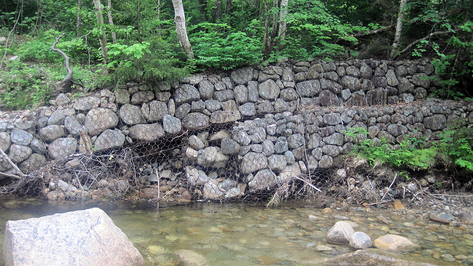
This summer I returned with two students to the Zealand River near Twin Mountain NH to see what 50 years of gabions, rock-filled wire baskets that are roughly 3 ft x 3 ft x 12 ft, have done to the river. The short answer is nothing good.
I have been to this site multiple times over the years, but it still catches me a little bit by surprise when I see the scale of the project and the immensity of the mess it left behind. The Zealand River is a classic example of how overreaction to a flood can lead to projects that create decades of bad outcomes for rivers and the fish they contain. When rivers flood they tend to change the landscape as we saw recently with the flooding by Hurricane Irene in Vermont.
On the Zealand River, flooding in the late 1950s prompted the project designed to prevent bank erosion. Thousands of wire-mesh baskets were filled with rock and placed in rows along the edges of the river to wall in the river and wall out sediment. A few gabions were also strung across the river to prevent the river from cutting down. Of course, the reason we have valleys is because rivers erode down. Floodplains are the result of the lateral motion project designers wanted to eliminate. The gabion installation was an attempt to force a river to no longer act like a river. Not surprisingly, the river is still a river and it still is acting like one.
The first thing to fail was probably the gabion dams, weirs and sills strung across the channel. Bedload rolling across the wire would have created plenty of abrasion of gabion wire and eventually weakened the structures. With the gabions damaged, downcutting of the newly walled in river accelerated because of the deeper, faster current. As the bed of the river began to lower, gabion walls became undermined. Soon walls pitched forward and fell into the river. In areas were the walls fell in, the river often created avulsions with new channels cut into the floodplain, further undermining gabion walls.
Today the Zealand River is a muddled scene of destroyed walls, abandoned sections of channel, wide zones dominated by massive deposition of eroded sediments and lots of tangled wire. There is little habitat created my large wood and shade is mostly absent. Fish are not particularly plentiful despite efforts to stock the river. The Zealand River is not a place anyone would want to paint, have a picnic or spend the day fishing. Perhaps, it could be a place where we learn from our mistakes and remember to let rivers behave like rivers, even when they flood.
I have been to this site multiple times over the years, but it still catches me a little bit by surprise when I see the scale of the project and the immensity of the mess it left behind. The Zealand River is a classic example of how overreaction to a flood can lead to projects that create decades of bad outcomes for rivers and the fish they contain. When rivers flood they tend to change the landscape as we saw recently with the flooding by Hurricane Irene in Vermont.
On the Zealand River, flooding in the late 1950s prompted the project designed to prevent bank erosion. Thousands of wire-mesh baskets were filled with rock and placed in rows along the edges of the river to wall in the river and wall out sediment. A few gabions were also strung across the river to prevent the river from cutting down. Of course, the reason we have valleys is because rivers erode down. Floodplains are the result of the lateral motion project designers wanted to eliminate. The gabion installation was an attempt to force a river to no longer act like a river. Not surprisingly, the river is still a river and it still is acting like one.
The first thing to fail was probably the gabion dams, weirs and sills strung across the channel. Bedload rolling across the wire would have created plenty of abrasion of gabion wire and eventually weakened the structures. With the gabions damaged, downcutting of the newly walled in river accelerated because of the deeper, faster current. As the bed of the river began to lower, gabion walls became undermined. Soon walls pitched forward and fell into the river. In areas were the walls fell in, the river often created avulsions with new channels cut into the floodplain, further undermining gabion walls.
Today the Zealand River is a muddled scene of destroyed walls, abandoned sections of channel, wide zones dominated by massive deposition of eroded sediments and lots of tangled wire. There is little habitat created my large wood and shade is mostly absent. Fish are not particularly plentiful despite efforts to stock the river. The Zealand River is not a place anyone would want to paint, have a picnic or spend the day fishing. Perhaps, it could be a place where we learn from our mistakes and remember to let rivers behave like rivers, even when they flood.
 RSS Feed
RSS Feed
